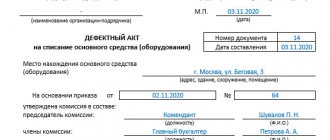By means of an act of damage to property, the fact of damage to the property of an individual or legal entity is documented. The range of legal relations during which there is a need to record the fact of property damage is very wide - from the banal flooding of an apartment to damage to rented property. Files in .DOC: Form of act of damage to propertySample act of damage to property
Grounds for drawing up the act
In the course of civil legal relations, not only citizens or enterprises participate, but also their property. Closely intertwined with property are contracts of supply, transportation, barter, loans, purchase and sale, lease and many others.
Property, like any item in the material world, is subject to wear and tear, damage due to natural causes or damage, both intentional and unintentional.
An act of damage to property is drawn up when the property itself obviously contains traces of a negative impact, namely:
- traces of improper transportation, expressed in dents, chips, damage, etc.;
- traces of improper or careless use of property, for example, scratches on furniture, dirt on wallpaper, broken glass in window or doorways;
- traces of violations of the technology for using property, for example, car springs bursting from overload or a computer burned out without using a UPS.
A common feature of all of the above options is the sign that the property is in the hands of a non-owner. Any person who temporarily owns the owner’s property on the basis of a lease, loan, operational management, transportation of goods or provision of repair services can act as a non-owner.
Types of memos
The following types of memos can be distinguished.
Report. In it, the author (employee, manager) notifies the recipients (management, other employees) about any internal situation in the company. For example, about recalling an employee from vacation due to production needs, about self-isolation after returning from a disadvantaged region, about transferring to remote work, etc.
Order an electronic signature for working with your personal account on mos.ru Receive in an hour
Explanatory. This “service” contains information about any internal processes in the organization. For example, the introduction of a new electronic system for handling complaints. Or about the transfer of internal corporate communications into electronic form - help desk, forums, etc.
Explanatory. Such a note reveals the causes of a particular problem, event or violation. For example, the reasons for mistakes made, the release of defective products, equipment or software failure.
Analytical . It serves to send a message about the current situation or information collected on a particular problem. In particular, such a note may set out conclusions based on the results of internal audits. Or the results of using new materials and methods, using programs during the test period, etc.
Material. Such “services” are needed to request certain resources. For example, purchase office supplies, computers, personal protective equipment; repair or replace equipment, etc.
In practice, a mixture of the listed types often occurs. That is, one document can contain elements of several types of “services” at once. For example, an explanatory note can also be analytical if it includes not only objective information on a particular issue, but also a list of measures to eliminate identified deficiencies.
Purpose of the act
Damage to property is almost always the basis for filing financial claims for compensation for damage caused. For this reason, timely and reliable recording of the fact of causing this harm, that is, the fact of damage to property, is extremely important.
We would like to draw the reader's attention to the need to differentiate intentional or unintentional damage from natural wear and tear or damage caused by force majeure.
Differentiation is made by intent or negligence of the person who committed the damage. Intentional damage is difficult to prove, and if it is proven and the damage is significant, then we can talk about the signs of a criminal offense.
Unintentional damage is also a culpable action, but within the framework of a civil tort, that is, civil liability. Differentiating damage from natural wear and tear is difficult, so it is differentiated through specialized examination.
Business entities draw up an act in any case, regardless of the presence of intent or its absence, or the impact of force majeure. It’s just that the text of the act itself notifies the presence or absence of someone’s guilt.
Sample Certificate of Lost Property of an Organization
I deposited outerwear and a dark-colored drape coat in the wardrobe of Law Raa LLC. A real act was drawn up regarding the following: 11/11/2015 deputy head of the technical department of Zhmykov. At 14:30 on the same day, Zhmykov. At work in the above clothing. The act of loss of property is the fact of the loss of property. The contract may provide for the obligation of the pledgee to compensate the pledgor for other losses caused by loss or damage to the pledged item. The act of loss of property, the fact of the loss of property, theft in the criminal code is understood as the unlawful gratuitous seizure and or circulation of someone else's property for the benefit of the perpetrator or other persons, committed for personal gain and causing harm to the owner or other holder of this property. The landlord has the right to demand from the tenant the fulfillment of obligations, and also to carry out, at any time at his own discretion, an inspection of the condition of the rented residential premises and things provided for in the rental contract and the current legislation of the Russian Federation on the use of housing. The pledgee is liable for the loss of the pledged item in the amount of its market value by which this value has decreased, and for its damage in the amount at which the pledged item was valued under the pledge agreement, regardless of the amount. He presented a token to receive his outerwear, but under the storage location for Zhmykov’s coat indicated on the token. Moscow by me, the head of the personnel department of the meter. The loss of someone else's property, revealed as a result of the inventory of inventory, is the basis for the recovery of damages. In the presence of legal adviser Rusinov. If, as a result of damage to the subject of pledge, it has changed in such a way, the pledgor has the right to renounce it and demand compensation from the pledgee for its loss, which cannot be used for its intended purpose.
- The manager draws up an order or instruction to conduct an audit in connection with a change in the MOL.
- The property manager temporarily transfers all valuables to the accounting department or committee members. In this case, the employer is provided with a receipt confirming the fact of the transfer, as well as that all received property has been delivered to the parish, and the disposed assets have been written off.
- The manager creates an inventory of property and/or an act.
- On the day of the MOL change, the values are recalculated and checked; these procedures are reflected in the act and transferred to the chief accountant and management of the enterprise.
Drawing up an act
The owner has the right to present material claims for compensation for damage caused to property. Accordingly, the fact of damage is recorded by the owner or his representative (which is typical for legal entities).
Since any act is a commission product, a commission of at least 3 people must be involved in its preparation.
It is allowed to involve invited specialists in drawing up the act if the act is drawn up in relation to damage to high-tech property and the assessment of damage requires special knowledge.
The content of the act of damage to property is not regulated by law, and therefore it is drawn up in an arbitrary manner in compliance with standard norms for maintaining business documentation.
The structure of an act on damage to property does not change depending on the type of legal relationship and includes a number of structural elements that are mandatory for acts in general, namely:
- the name of the document itself;
- date and place of drawing up the act;
- name list of commission members. For acts drawn up by legal entities, an indication of the positions and powers of the commission members will also be required;
- general information about the property that was damaged, including its name, quantity and reasons for which the property was in the use of the guilty person (lease agreement, loan agreement, cargo transportation agreement, etc.). If we are talking about many items of property, then it will be more convenient to arrange the list in the form of a table;
- description of the detected damage;
- amount of damage (as a rule, an approximate cost is indicated, since the amount of damage will be calculated not only based on damage, but also taking into account natural wear and tear). It is acceptable to indicate fixed amounts if items that were not in use were rendered completely unusable, for example, during the transportation of cargo;
- information about the person who is responsible for the damage (tenant, carrier, repair company);
- a general description of the reasons why the damage occurred, for example, wooden coverings were damaged as a result of the construction team using low-quality varnish. In this case, it is quite appropriate to indicate the opinion of an invited specialist;
- information about the impact of force majeure in the event that the property was damaged as a result of a natural disaster, flood or termite infestation;
- the commission’s conclusions about the consequences of causing damage to property and the possibility of its further use;
- conclusion of an invited specialist;
- information about the technical means of recording used during the inspection and drawing up the report, for example, photographic or video equipment;
- application list (optional);
- signatures of commission members and invited experts;
- signature of the guilty person in familiarizing himself with the act and receiving a copy of it.
The refusal of the guilty person to sign and receive a copy of the act should be recorded in another act - “On Refusal to Sign”. An act is drawn up in the number of copies corresponding to the number of parties interested in the act.
How to write a memo
First you need to specify the recipient (or several recipients) of the “service”. Typically these are officials of the organization. The corresponding details are usually placed in the upper right part of the document. In this case, the name of the position is indicated in the dative case (i.e., it answers the question “to whom?” - director, chief). And then the surname and initials of the recipient of the note are entered (clause 5.15 of GOST).
Then its name is written in the center of the document (clause 5.9 of GOST). And below you can place a heading reflecting a brief content of the “service” and giving an explanation of what topic it was compiled on (clause 5.17 of GOST).
The text of the document follows. The circumstances that served as the basis for drawing up the memo are reflected here, and arguments are given. After this, the request or message is stated directly. In this part of the document, the initials should also be indicated after the surname.
Important
When designating the addressee and in the text of the “service”, the initials are indicated after the surname. And when deciphering the signature - in front of it.
Exchange electronic documents with employees Inbox free
The preparation of the document is completed by affixing a signature. It includes the name of the author’s position (if the “service letter” is not issued on the organization’s letterhead, the name of the company is also indicated), the signature itself and its transcript. In this case, the initials are indicated first, and then the surname. If a document is drawn up by several persons who occupy different positions in the organization, then their signatures are located one below the other in the sequence corresponding to the hierarchy of positions held (clause 5.22 of GOST).
And the final touch is to indicate the date (and, if necessary, also the time) of signing. This information is located under the signature. You can specify the date in one of two ways. Either in Arabic numerals separated by a dot: 10/05/2021, or in a verbal-numeric way: October 5, 2021 (clause 4.10 of the Guidelines for the application of GOST R 7.0.97-2016).
Attention!
When specifying the date in numbers separated by dots, the first two details always contain 2 digits (i.e. January 5 must be indicated as 01/05), and the letter g is not inserted after the year. If the date is indicated verbally and digitally, then the number 0 before the day is not used (i.e. it is written as January 5, not January 5), and the letter g is written after the year.
Recovery of damages exceeding average earnings
It is possible to forcefully receive an amount of damage exceeding the average monthly income of the perpetrator only through the court. You will also have to go there when the employee stops paying, having initially agreed to voluntary compensation.
The statute of limitations for such claims is 1 year from the date of discovery of the damage or from the day when the employee was supposed to make payment for the damage caused, but did not do so (Part 3 of Article 392 of the Labor Code of the Russian Federation). Missing this deadline in itself does not deprive the employer of the right to go to court. The claim will be denied only if the employee declares that the deadline has been missed (Article 199 of the Civil Code of the Russian Federation).
Before going to court, although it is not necessary, it is advisable to send a claim to the employee.
By the way, the employer has the right to fully or partially exempt the employee from compensation for damage by formalizing his decision with an order. However, there are tax risks associated with assessing the compensation exemption as income to the employee. Accordingly, additional personal income tax assessment is possible (letter of the Ministry of Finance of Russia dated August 22, 2014 No. 03-04-06/42105). The opposite point of view is set out in the letter of the Federal Tax Service dated April 18, 2013 No. ED-4-3/ [email protected]
How to take into account the recovery of damages from an employee for income tax purposes? The answer to this question is in ConsultantPlus. Get trial demo access to the K+ system and access the material for free.
What else to download on the topic Act
- An employment contract defines the relationship between employer and employee. The compliance of the parties with the rights and obligations provided for by it depends on how thoroughly the terms of the relationship between the parties who entered into it are taken into account.
- Borrowing money is a phenomenon that is quite characteristic and widespread in modern society. It would be legally correct to issue a loan with subsequent documented repayment of funds. To do this, the parties draw up and sign a loan agreement.
- It's no secret that a legally competent approach to drawing up an agreement or contract is a guarantee of the success of the transaction, its transparency and security for counterparties. Legal relations in the field of employment are no exception.
- In the course of business activities of many companies, a supply agreement is most often used. It would seem that this document, simple in its essence, should be absolutely clear and unambiguous.
Drawing up a property damage report can be difficult for an unprepared person. There is no standard model established by law, so you have to be guided by the requirements of civil law.
car inspection report:
.doc | .pdf
In the future, the Act may be required in order to defend your interests in court.
Therefore, when drawing up such a document, it is better to use the help of experienced lawyers - they will suggest the correct wording and advise what to pay attention to in the subject area. You must strive to ensure that every phrase in the act is unambiguous and cannot be interpreted in favor of your opponent
The decision to draw up an act of causing property damage to an enterprise
An employee who discovers a breakdown of technological equipment, technical means, or other property of the enterprise must immediately inform its managers.
This information can be conveyed orally or stated in a memo (this form of report is preferable, as it can be useful if the case is brought to trial in order to demand financial compensation from the perpetrator). Depending on the complexity of the property and the extent of damage caused to it, the head of the enterprise makes a decision. To assess the damage, a special commission is created from company specialists or an independent assessment organization is engaged (under contract).
Important! If an internal evaluation commission is created, the results of its work are necessarily recorded in an act.
Act on damage to property due to inadequate quality of utility services
The basic requirements for the procedure for drawing up a report on damage to the property of a consumer of utility services due to inadequate quality of their provision at the federal level are regulated by Ch. XVI Resolution of the Government of the Russian Federation “On the provision of public services...” dated 05/06/2011 No. 354. It is indicated that such an act (clause 152):
- compiled by the contractor (i.e., the company providing the relevant utility services) no later than 12 hours from the moment the consumer contacts the emergency dispatch service;
- signed by the contractor and the consumer or, if it is not possible to obtain the signature of the latter, by 2 disinterested persons;
- must contain a description of the damage caused and the circumstances under which such damage was caused.
The procedure for issuing an inspection report can also be established at the regional level (see Appendix 2 to the order dated March 12, 2001 of the City Order Department of the Moscow Government No. 55-48/1, Housing and Communal Services and Improvement Department of the Moscow Government No. 5-37/1 ).
Document text
Limited Liability Company “Dar” ACT 01/02/2012 N 1 Minsk On the identification of material damage Compiled by the commission: Chairman - head of the production department O.B. Smirnov. Members of the commission: 1. Chief engineer of the production department A.A. Polyakov. 2. Chairman of the trade union committee A.I. Tereshchenko. 3. Head of the legal department V.V. Tarasov. 4. Chief accountant S.A. Petrenko. 5. Warehouse storekeeper A.S.Ivanov. During the internal investigation conducted on 01/02/2012, it was established that V.M. Kravtsov, a 4th category storekeeper, on 12/30/2011, when returning from work on public transport, lost a package with a set of special clothing issued to him, which he was taking home for cleaning after work. 01/02/2012 with V.M. Kravtsova a written explanation of what happened was requested by 02/05/2011. This is the explanation of V.M. Kravtsov. refused to present what the corresponding act was drawn up. Kravtsov V.M. is a financially responsible employee, an agreement on full financial responsibility was concluded with him. Based on the results of the assessment of lost property, as of December 2, 2012, the cost of the damage caused amounted to 2,000,000 (two million) Belarusian rubles. Based on the established facts, it was revealed that V.M. Kravtsov. material damage was caused in the amount of 2,000,000 (two million) Belarusian rubles. Appendix: 1. Copy of the internal investigation report dated 01/02/2012 N 1 on 2 pages. in 1 copy. 2. Copy of the shift schedule dated November 29, 2011 N 1 per 1 sheet. in 1 copy. 3. Copy of V.M. Kravtsov’s work instructions. dated 03/14/2011 for 5 l. in 1 copy. 4. A copy of the requirement to provide a written explanation dated 01/02/2012 N 1 on 1 page. in 1 copy. 5. A copy of the act of refusal to provide a written explanation dated 01/02/2012 N 2 on 1 page. in 1 copy. 6. Copy of the agreement with V.M. Kravtsov. on full individual financial liability dated 10/12/2010 N 54 for 2 l. in 1 copy. Signature A.S.Ivanov Signature S.A.Petrenko Signature A.A.Polyakov Signature V.V.Tarasov Signature A.I.Tereshchenko Signature O.B.Smirnov
A neighbor caused damage to property, how to draw up an inspection report
Assessment of losses as a result of illegal or careless actions of third parties. The act is drawn up in 3 copies, signed by all citizens present during the inspection of the damaged residential premises, approved by the director of the management company and handed over one at a time to representatives of the guilty and injured parties. In this case, the management company should be notified in writing, and the act should indicate that it was informed, but did not participate in drawing up the act due to failure to appear when called. It is also possible to draw up the document in a tabular form - in some cases this form is more suitable.
Shelf life
According to the List of standard management archival documents generated in the course of the activities of state bodies, local governments and organizations, indicating storage periods, approved by Order of the Ministry of Culture of Russia dated August 25, 2010 No. 558, internal memos must be stored in the archives of the enterprise for at least five years.
If necessary, the director of the organization has the right to extend the storage period. The storage period for documents issued electronically may be determined by the company's charter. URGENTLY!
Hurry up to understand FSBU 5/2019 “Inventories” before you are fined . The easiest way is a short but complete advanced training course from accounting guru Sergei Vereshchagin
- Duration 25 hours for 1 month
- Your ID in the Rosobrnadzor register (FIS FRDO)
- We issue a certificate of advanced training
- The course complies with the professional standard “Accountant”
View full program
Determining the amount of damage
In accordance with Article 246 of the Labor Code of the Russian Federation, the amount of damage is determined depending on the actual losses based on the market value of the property. This amount should not be lower than the residual value of the property according to accounting data.
To determine actual losses caused by property damage, it is necessary:
- Establish the value of the property before the moment of damage. We are talking about the so-called residual value according to accounting data;
- Determine the market value of the property after the damage has occurred. This can be done on the basis of an independent expert assessment report;
- Calculate the amount of actual losses - the difference between the value of the property before and after the damage occurred.
When drawing up the act, it is advisable to include a professional appraiser on the commission. This is due to the fact that it is not always possible to justify the amount to be reimbursed. To avoid further disputes, it is advisable to attach to the document a document on the assessment of such damage, drawn up by an expert.
Compiled by whom?
Any owner whose property has been damaged can draw up an act of property damage. If we are talking about the organization’s property, an authorized person will be engaged in drawing up a document about damage to property.
Typically this is done by the following people:
- Company in-house lawyer;
- Secretary;
- Head of department;
- Accountant;
- Specially appointed responsible person.
It is important to note that when drawing up the act, other persons must be present to act as witnesses. This could be neighbors, if we are talking about damage to property in the apartment, or other company employees, if we are talking about damage to corporate property.
A special commission is formed, which must consist of at least three people. If we are talking about damage to high-tech equipment or devices, you should hire a third-party expert to more accurately diagnose the damage.
How to submit electronically
Many enterprises have adopted electronic document management.
Therefore, the memo, an example of which was written above, can be issued electronically. In this case, it is sent to the enterprise’s corporate email. The secretary is responsible for further sorting and forwarding of letters to recipients. This transfer method saves paper and employee time. In this case, the document is drawn up in the same way as on paper. It is advisable that it bears the electronic signature of the sender. To make sure that the sent document has been read by the manager, when sending, you should request a “mail read receipt” by checking the box on the sending form.
How to draw up a property damage assessment report
Such a document can be drawn up in free form. Each company has its own rules, so its template may differ, but the act must reflect the following points:
- date, place of execution of the document, name of the legal entity;
- composition of the evaluation commission, full names of its members;
- name, description of the item of property that was damaged, its book value, residual price according to accounting;
- reasons, circumstances due to which the property was damaged;
- the guilty person (if one has been identified);
- what measures have been taken to identify the culprit (if she could not be immediately identified);
- conclusion of the commission on the results of the work.
Important! All members of the commission must sign the act.
Next, the completed act, signed by the commission, is submitted for consideration to the company’s management, who draws up an order for compensation for damage and delivers it to the culprit against signature. Such an order must be drawn up no later than one month from the date of the incident.
Important! If the guilty person refuses to compensate for the property damage she caused to the company, management has the right to file a claim in court.
Practice of application of the act for reimbursement of costs
A deed is not just a piece of paper, but a tool for collecting damages. Success in compensating or restoring damaged values depends on how complete and well-reasoned the content of the document is drawn up.
This is especially important for judicial proceedings, since the court prefers to rely on documentary evidence, and only as a last resort takes the words of the victim and witnesses on faith.
With the voluntary consent of the guilty party
If the party who is found guilty is ready to compensate for the damage, the act is used as the basis for collecting the amount, since it reflects the amount of losses incurred. In this situation, it is the one who agreed to pay the costs who is interested in receiving a second copy, so that in the future the owner will not be tempted to distort the facts. Together with the act, complete security from unscrupulous attempts will be ensured by a receipt from a cash order or from a bank for compensation for damage in cash.
Sample report of stolen property
- Information about the employee who is responsible for intentional or accidental damage to property.
- Information about the incident that resulted in the loss of property and the reasons that caused it.
- An explanatory note from the employee or a mention of refusal.
- The amount of damage incurred (the exact amount that must be confirmed by an inventory and is the difference between the actual availability of property and the latest accounting records).
- The connection between the employee’s actions and the damage suffered, evidence of his involvement and the presence of illegal actions.
If you decide to transmit information by phone, the duty officer will record the fact of theft, which is subject to verification only if you introduce yourself, give the address of your actual residence and provide contact information. If the application is submitted in person or sent by mail, it must be signed.










